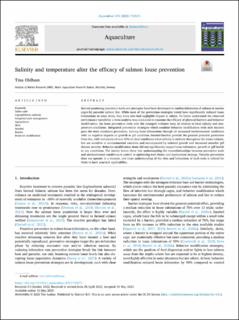| dc.description.abstract | Several promising preventive tools and strategies have been developed to combat infestation of salmon in marine cages by parasitic salmon lice. While most of the prevention strategies tested have significantly reduced louse infestations in some trials, they have also had negligible impact in others. To better understand the observed performance variability a meta-analysis was conducted to examine the efficacy of physical barriers and behavior modification, the louse prevention tools with the strongest evidence base, in relation to local salinity and temperature conditions. Integrated prevention strategies which combine behavior modification with skirt barriers gave the most consistent protection, halving louse infestations through all measured environmental conditions with no negative impacts on growth or gill condition. Snorkel barriers provide the greatest potential protection from lice, with reductions of over 80% in ideal conditions when salinity is uniform throughout the water column, but are sensitive to environmental variation and accompanied by reduced growth and increased amoebic gill disease severity. Behavior modification alone did not significantly impact louse infestation, growth or gill health in any conditions. The results herein show that understanding the interrelationships between preventive tools and environmental conditions is central to optimizing tool choice and deployment strategy. Parasite prevention does not operate in a vacuum, and clear understanding of the risks and limitations of such tools is critical for them to have practical applicability. | |
